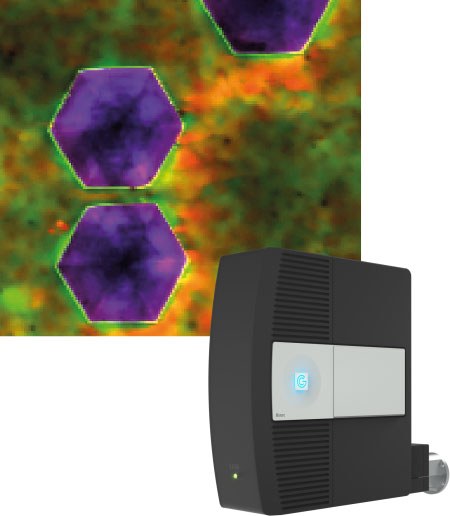Using SEM-based Cathodoluminescence to Study Light Emission at Nanoscale Spatial Resolution
How cathodoluminescence can be used to study the emission patterns of nitride semiconductor micropillars for microLEDs in displays, including wearable devices.
The Gatan Monarc SEM-based CL detector features a unique WARCL mode that can be used to assess how micropillar emission affects colour rendering, for device development and quality control.
This research has been published in a paper entitled “Use of Wavelength- and Angle-Resolved Cathodoluminescence for Spectroscopic Analysis of the Emission Pattern of a Nitride Semiconductor Micro Pillar Array” by J. Lee, M. Bertilson, J. D. Stowe,T. Worsley and J. A. Hunt. The full paper is available here.
Blue Scientific is the official distributor for Gatan’s range of systems for electron microscopes in Norway, Sweden, Denmark, Finland and Iceland. For more information or quotes, please get in touch.
Gatan Monarc
Contact us on +44 (0)1223 422 269 or info@blue-scientific.com
Follow @blue_scientificCathodoluminescence
Cathodoluminescence (CL) involves analysing the wavelengths of light emitted from a sample stimulated by the electron beam of an SEM (Scanning Electron Microscope). It’s often used to study quality and compositional variations in materials in compound semiconductors, and light-matter interaction in nanophotonics.
What is cathodoluminescence?Direction and Polarisation Distribution
Traditionally, cathodoluminescence detectors measure only the wavelength distribution of the emitted light. However, it’s now possible to also measure the direction (angle) and polarisation distribution.

WARCL
WARCL (Wavelength- and Angle-Resolved Cathodoluminescence) is a technique for acquiring information about wavelength and angular distributions simultaneously. Data is captured over a large numerical aperture, with virtually no loss in resolution.
This technique has been used to study emission patterns as a function of wavelength. This has particular relevance to nitride semiconductor micropillar arrays for display applications.
Micropillar Arrays in Displays
MicroLED arrays and nitride semiconductor micropillars have great potential for display applications, delivering up to a 30x improvement in energy efficiency. When combined with their colour rendering index, this could deliver enhanced light extraction and controllable emission patterns.
For optimal light extraction and uniform colour rendering at the required emission angles, it’s important to understand how the structural properties of the micropillars relate to their emission patterns. This can be done through spectroscopic analysis, using the Gatan Monarc CL system.
Example Analysis
In this example, a 10 x 10 array of core-shell GaN-InxGa1-xN micropillars was measured using the Gatan Monarc CL system attached to an FE-SEM.

Intense light emission was observed across the visible spectrum (400 – 720 nm). This was dominated by a strong blue emission from the InGaN multi-quantum wells and a yellow band emission due to point defects.
Wavelength-resolved spectrum imaging was used to study spatial variation in the InGaN emission wavelengths from a single micropillar. This highlighted significant variation in the InGaN emission wavelength, associated with differences in alloy composition. The indium fraction of the alloy was found to vary between x = 0.104 and x = 0.152, and accumulations of indium were located.
ARCL Emission Pattern
An emission pattern was then captured using ARCL (Angle-Resolved CL) with the Monarc. This showed significant anisotropy. Six emission maxima were observed normal to the six {10-11} facets of the hexagonal pyramid. Emission in the direction close to the substrate surface normal was about 5 times weaker.

The ARCL pattern lacks the sensitivity required to determine the uniformity in emission colour across different viewing angles.
However, WARCL was used to reconstruct emission patterns at 670 wavelengths across the visible spectrum (spectral resolution ~0.63 nm). Variations are apparent in the different wavelengths. For example, the emission spectrum (colour rendering) varied as a function of the emission direction (viewing angle).

The emission pattern by colour is thought to be affected by the size, shape, quality and periodicity of the micropillar. Further research is being conducted to fully understand how each factor affects this.
SEM-based CL has proven to be a useful technique for studying the emission properties of both single micropillars and arrays, and how they affect structural properties.
This research has been published in a paper entitled “Use of Wavelength- and Angle-Resolved Cathodoluminescence for Spectroscopic Analysis of the Emission Pattern of a Nitride Semiconductor Micro Pillar Array” by J. Lee, M. Bertilson, J. D. Stowe,T. Worsley and J. A. Hunt. The full paper is available here.

Gatan Monarc
Cathodoluminescence system for SEM
- Most complete CL analysis to date
- Unique wavelength- and angle-resolved capabilities
- Unmatched spatial (<10 nm), angular (1°) and wavelength (0.1 nm) resolution
- Lare field of view
More Information
Blue Scientific is the official distributor of Gatan systems in the Nordic region. We’re available to answer all your questions – just get in touch:


